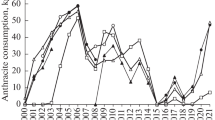Abstract
Subjecting natural gas to multi-stage heating by passing it through the cooled cavities of certain tuyere elements instead of coolant water is technically simple to accomplish and makes it possible to heat the gas to 300°C or more, the exact temperature depending on the amount of gas used. The cost of instituting this technology is an order of magnitude lower than the savings realized by injecting heated natural gas into blast furnaces. The injection of heated natural gas into a blast furnace introduces additional heat into the furnace and makes it possible to use more natural gas in the smelting process without reducing the theoretical combustion temperature. It also increases the value of the coefficient that characterizes the replacement of coke by natural gas, since the gas undergoes more complete combustion in this case. Finally, the injection of heated natural gas results in a more uniform distribution of hydrogen across the furnace and allows fuller use of this element in the smelting operation.
Similar content being viewed by others
References
A. N. Ramm, Modern Blast-Furnace Smelting [in Russian], Metallurgiya, Moscow (1980).
K. M. Bugaev, Distribution of Gases in Blast Furnaces [in Russian], Metallurgiya, Moscow (1974).
V. N. Andronov, Modern Blast-Furnace Smelting: Handbook [in Russian], St. Petersburg State Technical University, St. Petersburg (2001).
V. K. Kornev, V. E. Gasparyan, V. G. Tikhonov, and V. I. Yukhimenko, “Possibilities for making more efficient use of natural gas in blast-furnace smelting,” Stal’, No. 1, 7–9 (1991).
Yu. V. Lipukhin, I. F. Kurunov, V. K. Kornev, et al., “Blast-furnace operation with the injection of a gas-oxygen mixture into the hearth,” ibid., No. 2, 8–10 (1998).
V. I. Pleshkov, Yu. V. Savost’yanov, A. A. Meshcheryakov, et al., USSR Author’s Certificate No. 1771486, MKI5C 21B 7/16, Blast-Furnace Tuyere, Submitted 20.02.1991; Published 23.10.1992. Byul. No. 39.
Yu. V. Savost’yanov, S. K. Manaenkov, V. I. Kozoderov, et al., USSR Author’s Certificate No. 2009201, MKI5 C 21 B 5/00, Method of Blast-Furnace Smelting, Submitted 20.12.1991; Published 15.03.1994. Byul. No. 5.
M. I. Sharapov and G. P. Lezhnev, USSR Author’s Certificate No. 840116, MKI5 C 21 B 7/16, Blast-Furnace Tuyere, Submitted 05.12.1997; Published 23.06.1981. Byull. No. 23.
G. E. Sen’ko, “Cooling blast furnaces with natural gas,” Stal’, No. 10, 877–879 (1964).
G. V. Torokhov, I. F. Kurunov, and V. K. Kornev, “Effectiveness of injecting a gas-oxygen mixture into blast furnaces,” ibid., No. 5, 5–7 (1996).
Innovations in Ferrous Metallurgy Abroad. Supplement on Sinter Production [in Russian], Chermetinformatsiya, Moscow (2003).
Thermophysical Properties of Fuels and Charge Materials in Ferrous Metallurgy: Handbook [in Russian], Metallurgiya, Moscow (1982).
M. P. Beresneva and I. F. Kurunov, “Effect of the efficiency of use of natural gas on performance indices of a blast furnace,” Metallurg, No. 5, 34 (2001).
Author information
Authors and Affiliations
Additional information
__________
Translated from Metallurg, No. 11, pp. 44–48, November, 2007.
Rights and permissions
About this article
Cite this article
Feshchenko, S.A., Pleshkov, V.I., Lizunov, B.N. et al. Making blast-furnace smelting more efficient through the injection of heated natural gas. Metallurgist 51, 605–611 (2007). https://doi.org/10.1007/s11015-007-0110-5
Issue Date:
DOI: https://doi.org/10.1007/s11015-007-0110-5




